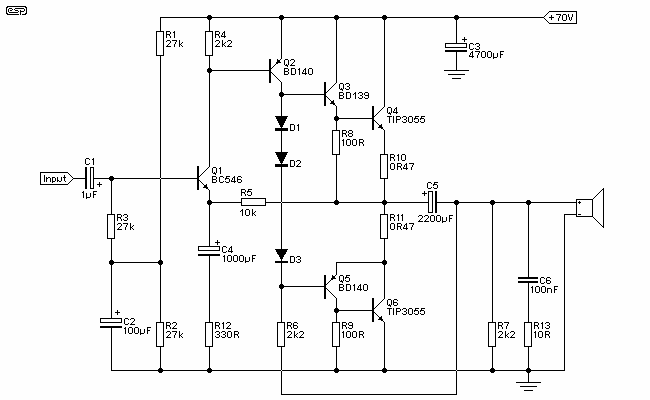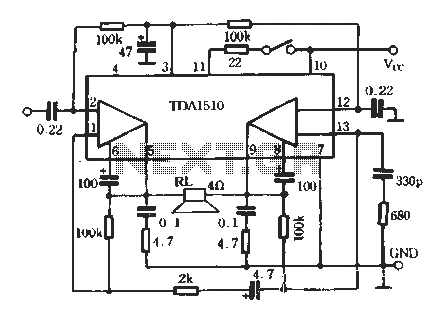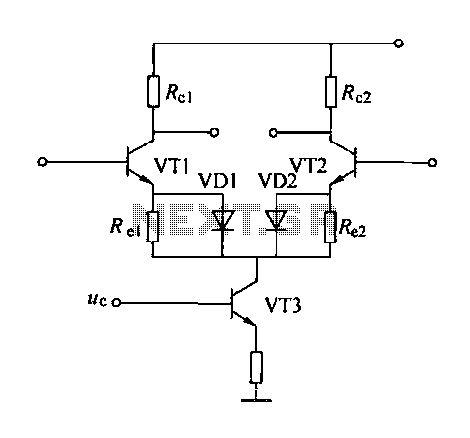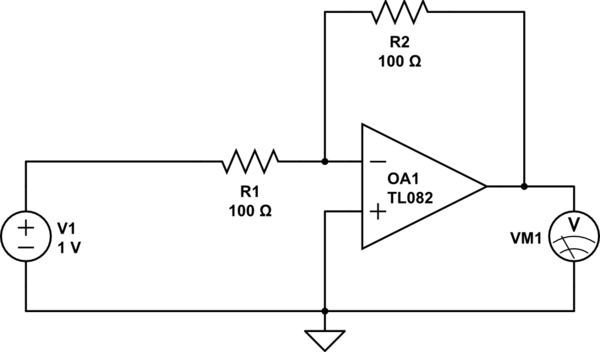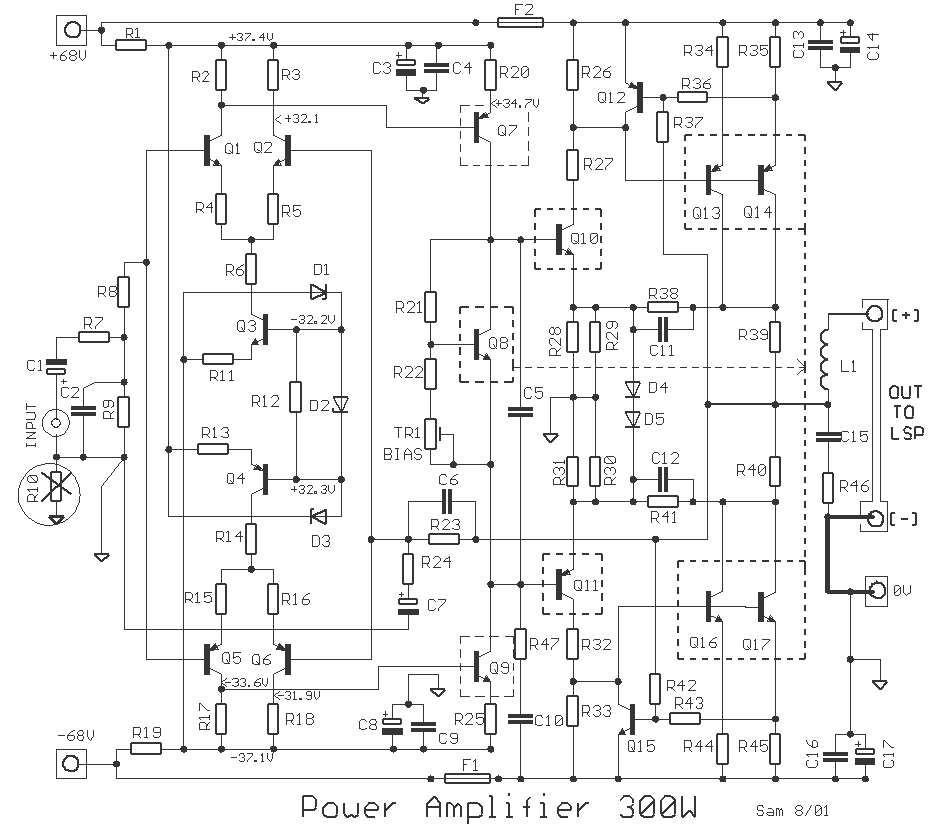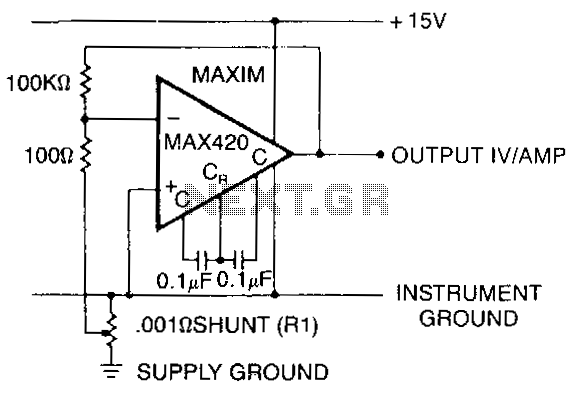
Receiver If Amplifier
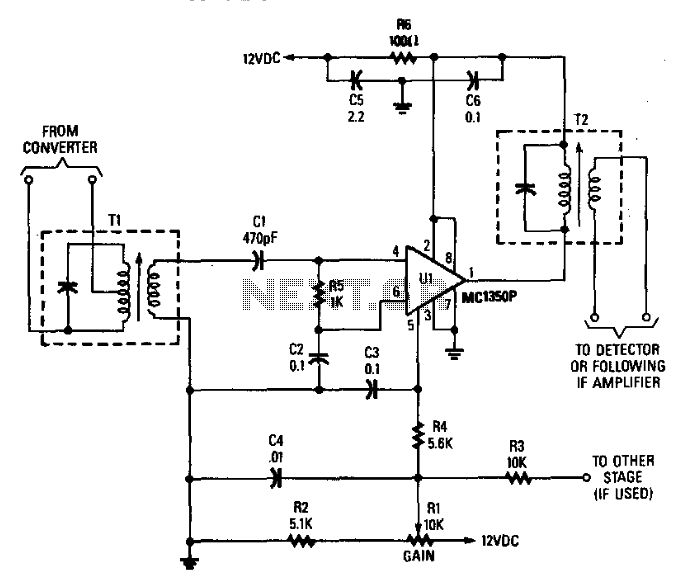
Tl is tuned to the converter output frequency Ul to provide a gain of 45 to 50 dB, depending on the design of Tl and T2. C2, C3, C4, C5, and C6 function as bypass capacitors. R5 serves as a bias resistor. The gain is determined by Rl, which regulates the voltage on pin 5 of Ul. Tl and T2 are designed to provide source and load impedances of 1 kΩ and 3 to 10 kΩ, respectively. R3 supplies DC bias to other stages if needed.
The circuit described involves a tuned amplifier configuration where Tl is optimized to match the output frequency of Ul, ensuring efficient signal amplification within the specified gain range of 45 to 50 dB. The gain variation is influenced by the characteristics and design parameters of the transformers Tl and T2.
The bypass capacitors C2, C3, C4, C5, and C6 are critical for maintaining stability and performance by filtering out unwanted AC noise and ensuring that the DC bias levels remain stable across the circuit. The inclusion of these capacitors helps to improve transient response and overall circuit reliability.
R5, as a bias resistor, plays a significant role in setting the operating point of the amplifier stages, ensuring that the transistors operate in the desired region for linear amplification. The gain control is achieved through Rl, which adjusts the voltage at pin 5 of Ul, allowing for fine-tuning of the amplifier's output level.
The impedance matching provided by Tl and T2 is essential for maximizing power transfer and minimizing reflections in the circuit. The specified source impedance of 1 kΩ and load impedance range of 3 to 10 kΩ are crucial for ensuring that the circuit operates efficiently within its intended application.
Additionally, R3 is included in the design to supply DC bias to other stages if necessary, further enhancing the versatility of the circuit by allowing integration with multiple amplifier stages or additional circuitry. This design consideration facilitates a broader range of applications while maintaining optimal performance characteristics. Tl is tuned to converter-output frequency Ul to provide 45-to-50-dB gain, depending on the design of Tl and T2. C2, C 3, C4, C5, and C6 are bypass capacitors. R5 is a bias resistor. Gain is set by Rl, which controls the voltage on pin 5 of Ul. Tl and T2 should provide source and load impedance of l-kft and 3- to 10-KOhmhm, respectively. R3 supplies dc bias to other stages, if required. 🔗 External reference
The circuit described involves a tuned amplifier configuration where Tl is optimized to match the output frequency of Ul, ensuring efficient signal amplification within the specified gain range of 45 to 50 dB. The gain variation is influenced by the characteristics and design parameters of the transformers Tl and T2.
The bypass capacitors C2, C3, C4, C5, and C6 are critical for maintaining stability and performance by filtering out unwanted AC noise and ensuring that the DC bias levels remain stable across the circuit. The inclusion of these capacitors helps to improve transient response and overall circuit reliability.
R5, as a bias resistor, plays a significant role in setting the operating point of the amplifier stages, ensuring that the transistors operate in the desired region for linear amplification. The gain control is achieved through Rl, which adjusts the voltage at pin 5 of Ul, allowing for fine-tuning of the amplifier's output level.
The impedance matching provided by Tl and T2 is essential for maximizing power transfer and minimizing reflections in the circuit. The specified source impedance of 1 kΩ and load impedance range of 3 to 10 kΩ are crucial for ensuring that the circuit operates efficiently within its intended application.
Additionally, R3 is included in the design to supply DC bias to other stages if necessary, further enhancing the versatility of the circuit by allowing integration with multiple amplifier stages or additional circuitry. This design consideration facilitates a broader range of applications while maintaining optimal performance characteristics. Tl is tuned to converter-output frequency Ul to provide 45-to-50-dB gain, depending on the design of Tl and T2. C2, C 3, C4, C5, and C6 are bypass capacitors. R5 is a bias resistor. Gain is set by Rl, which controls the voltage on pin 5 of Ul. Tl and T2 should provide source and load impedance of l-kft and 3- to 10-KOhmhm, respectively. R3 supplies dc bias to other stages, if required. 🔗 External reference
